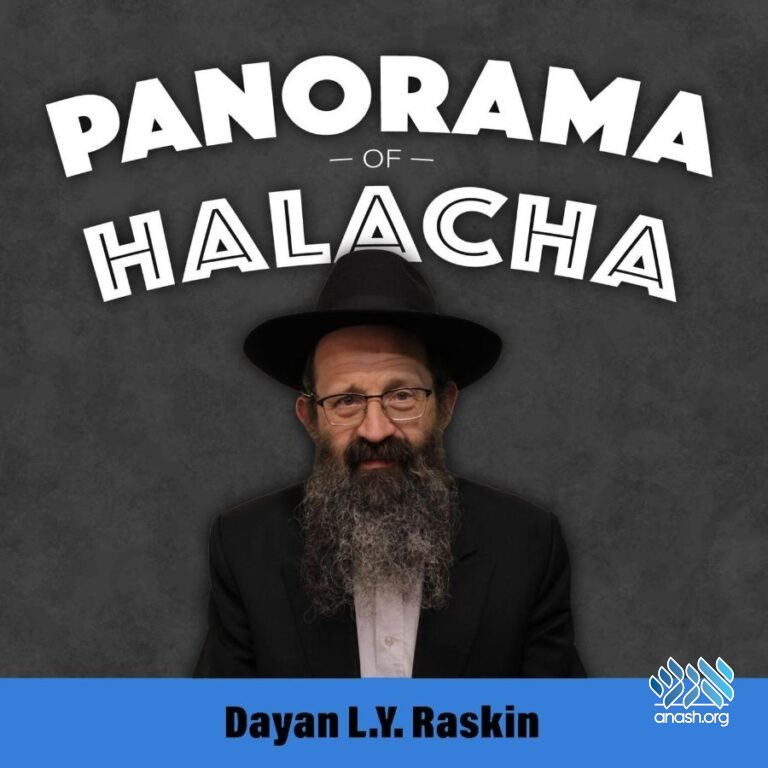Anash.org feature: Dayan Levi Yitzchok Raskin, Rov of Anash in London, explores interesting Torah questions and halachic dilemmas including using pictures taken on Shabbos, where Shaimos can be buried, gifting a book on Shabbos, and mezuzah at the workplace.
The following issues are discussed by Rabbi Raskin in this week’s episode:
- A man who has no sense of smell (Covid?) is reciting Havdolo; may he say the brocho over spices and his wife will enjoy the fragrance?[1]
- In a moment of duress, someone committed to keep Shabbos until Rabbenu Tam’s time. He now wishes to absolve that vow. Is that allowable?[2]
- Someone asked a non-Jew to take a photo on Shabbos. May one use that photo?[3]
- We don’t have space to bury ‘Shaimos’ in the cemetery. May we bury in the Shul yard?[4]
- In several letters of the Rebbe, the obligation of Mezuza at a workplace is contingent upon whether the space is used for eating. What’s the source for this position?[5]
- May I gift my Shabbos host a book on Shabbos?[6]
- What is our Minhag re. saying Kaddish at Shabbos Mincha, after leining?[7]
- Feedback on walking in front of one reciting Shmoine Esrei: What about Kaddish?[8]
- Follow-on from some weeks ago: Another explanation for the 23 or 25-minute margin for lighting candles for Shabbos: שעות זמניות.
- What’s the background to the changes in Haftorah [according to Minhag Chabad] for these two weeks?
To listen to Panorama of Halacha on a podcast, click here.
- [1] מבואר בשוע”ר סי’ רצז ס”ז שלא יברך.
- [2] במגן אברהם סי’ תקנא סק”ז מבואר שבחומרא כדעת פוסק מסויים, אין מועיל התרת נדרים. נסמן בליקוט לש”פ תולדות. וע”ע כל נדרי פע”ו ס”י, וש”נ. וכל זה לבד מהדיון אם אפשר להתיר נדר שנעשה בעת צרה (ראה רמ”א יו”ד סי’ רכח סמ”ה).
- [3] בס’ ארחות שבת ח”ב פכ”ג סל”ז הביא בשם הגריש”א לאסור, כי לא שייך כאן “בכדי שיעשו”. משא”כ בצלם של עיתון נכרי.
- [4] הגהות חתם סופר באו”ח סי’ קנד. בכנסת יחזקאל יחזקאל סי’ יד מגביל הקבורה למקום שאינו מדרס לבני אדם. בס’ גנזי הקודש (פט”ו ס”ח) ממליץ לשולחם לLANDFILL.
- [5] אגרות קודש ח ע’ לח; יג ע’ ח; יז ע’ ק. ראה שדי חמד ערך מזוזה (כרך ג ע’ תקלא ואילך), דלא כט”ז יו”ד סי’ רפו סק”י.
- [6] ראה שמירת שבת כהלכתה פכ”ט סכ”ט.
- [7] לשון ההוראה שבשולי ‘סדור תהלת ה’ השלם’ מהדורת תשל”ח:
- מנהגנו – הש”ץ מתחיל לומר חצי קדיש קרוב לסוף הגלילה, ומאריך באמירתו באופן שיסיים אחר כניסת הס”ת לארון.
- אכן בשנים האחרונות חלו שינויים בכל זה, כי כאשר הזדמן לכ”ק אדמו”ר זי”ע יארצייט בשבת, הי’ ממתין מלהתחיל הקדיש עד שיכניסו הספר־תורה אל ההיכל. ברם יתכן שאין לראות בזה שינוי דעת, כי אם שזה קשור עם שבאותה תקופה נהג כ”ק אדמו”ר זי”ע להתפלל מנחה תיכף אחר ההתוועדות, כאשר הוא נשאר במקומו שישב בזמן ההתוועדות ק’ – באמצע ביהכ”נ, ולא הלך אל מקומו שבקידמת ביהכ”נ, ליד ארון הקודש[7]. גם שלחן הקריאה העמידו אז סמוך למקום מושב כ”ק. עקב כך, אילו היה מתחיל הקדיש בעת גלילת הס”ת (כבקדמת דנא), הרי עקב עומס הקהל, היתה החזרת הס”ת למקומו מתאחרת הרבה, אחרי גמר הקדיש. ולכן נאלץ לנהוג כמנהג העולם, להמתין ולהתחיל באמירת הקדיש עד החזרת הס”ת למקומו. ואם כנים הדברים, הרי אין ללמוד ממנו לגבי שאר דוכתי, ויש להמשיך במנהג רבותינו נשיאנו דמקדמת דנא, וכהוראת כ”ק אדמו”ר זי”ע, להתחיל הקדיש קרוב לסיום הגלילה וכו’.
- [8] ראה קצות השלחן סי’ טז ס”ו.


Discussion
In keeping in line with the Rabbonim's policies for websites, we do not allow comments. However, our Rabbonim have approved of including input on articles of substance (Torah, history, memories etc.)
We appreciate your feedback. If you have any additional information to contribute to this article, it will be added below.